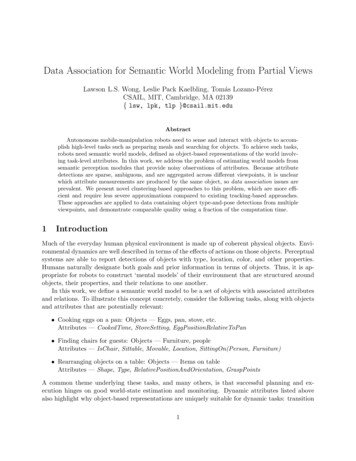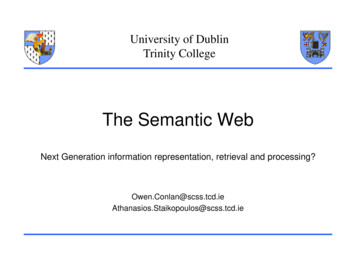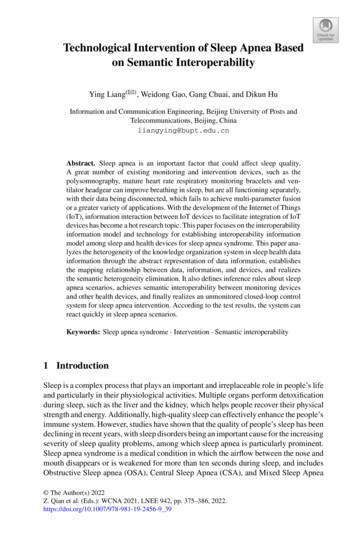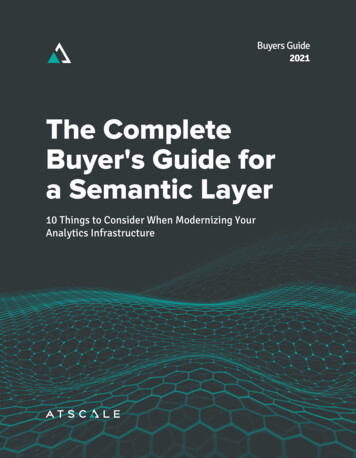
Transcription
Data Association for Semantic World Modeling from Partial ViewsLawson L.S. Wong, Leslie Pack Kaelbling, Tomás Lozano-PérezCSAIL, MIT, Cambridge, MA 02139{ lsw, lpk, tlp }@csail.mit.eduAbstractAutonomous mobile-manipulation robots need to sense and interact with objects to accomplish high-level tasks such as preparing meals and searching for objects. To achieve such tasks,robots need semantic world models, defined as object-based representations of the world involving task-level attributes. In this work, we address the problem of estimating world models fromsemantic perception modules that provide noisy observations of attributes. Because attributedetections are sparse, ambiguous, and are aggregated across different viewpoints, it is unclearwhich attribute measurements are produced by the same object, so data association issues areprevalent. We present novel clustering-based approaches to this problem, which are more efficient and require less severe approximations compared to existing tracking-based approaches.These approaches are applied to data containing object type-and-pose detections from multipleviewpoints, and demonstrate comparable quality using a fraction of the computation time.1IntroductionMuch of the everyday human physical environment is made up of coherent physical objects. Environmental dynamics are well described in terms of the effects of actions on those objects. Perceptualsystems are able to report detections of objects with type, location, color, and other properties.Humans naturally designate both goals and prior information in terms of objects. Thus, it is appropriate for robots to construct ‘mental models’ of their environment that are structured aroundobjects, their properties, and their relations to one another.In this work, we define a semantic world model to be a set of objects with associated attributesand relations. To illustrate this concept concretely, consider the following tasks, along with objectsand attributes that are potentially relevant: Cooking eggs on a pan: Objects — Eggs, pan, stove, etc.Attributes — CookedTime, StoveSetting, EggPositionRelativeToPan Finding chairs for guests: Objects — Furniture, peopleAttributes — IsChair, Sittable, Movable, Location, SittingOn(Person, Furniture) Rearranging objects on a table: Objects — Items on tableAttributes — Shape, Type, RelativePositionAndOrientation, GraspPointsA common theme underlying these tasks, and many others, is that successful planning and execution hinges on good world-state estimation and monitoring. Dynamic attributes listed abovealso highlight why object-based representations are uniquely suitable for dynamic tasks: transition1
(a) Single viewpoint(b) Aggregation of object detections from multiple viewpointsFigure 1: (a) Given a tabletop scene (top), we want to estimate the types and poses of objects in the scene using ablack-box object detector. From a single RGB-D image, however, objects may be occluded or erroneously classified.In the rendered image (middle; detections superimposed in red), three objects are missing due to occlusion, and thebottom two objects have been misidentified. The semantic attributes that result in our representation are very sparse(bottom; dot location is measured 2-D pose, color represents type). (b) Aggregation of measurements from manydifferent viewpoints (top) is therefore needed to construct good estimates. However, this introduces data associationissues of the type addressed in this work, especially when multiple instances of the same object type are present.From all the object detection data, as shown (bottom) by dots (each dot is one detection), our goal is to estimatethe object types and poses in the scene (shown as thick ellipses centered around location estimate; color representstype, ellipse size reflects uncertainty). The estimate above identifies all types correctly with minimal error in pose.dynamics tends to operate on the level of objects. For example, it is much more natural to expressand reason about eggs that are being cooked, as opposed to points in a point cloud or cells in anoccupancy grid that are ‘cooked’. Although we focus on the static case in this paper, our ultimategoal is to provide a framework for estimating and monitoring large semantic world models involvingobjects and attributes that change over time as a result of physical processes as well as actions bythe robot and other agents.In this work, we address the problem of constructing world models from semantic perceptionmodules that provide noisy observations of attributes. For concreteness, Figure 1 depicts an application of our methods; here the world model consists of objects’ types and poses, and attributemeasurements are outputs from a black-box object detector running continuously on sensed RGB-Dimages. Due to noise, occlusion, and sensors’ limited field of view, observations from multiple viewpoints will typically be necessary to produce a confident world model. Because attribute detectionsare sparse, noisy, and inherently ambiguous, where it is unclear which attribute measurements wereproduced by the same object across different views, data association issues become critical. Thisis the greatest challenge; if the measurement-object correspondences were known, the resultingobject-attribute posterior distributions would be efficiently computable.We begin by stating a formal model for a simplified 1-D version of the world-model estimationproblem in Section 3, and then review a classic solution approach based on tracking in Section 4.The main contribution of this work is the development of several novel clustering-based data association approaches, described in Sections 5 and 6. Application of the semantic world-modelingframework to object type-and-pose estimation is then demonstrated in Section 7, where we presentexperimental results using data collected with a Kinect sensor on a mobile robot.2
2Related WorkOur work lies in the intersection of semantic perception, world modeling, and data association,which we will first review before placing our contributions in context.2.1Semantic World ModelingUnderstanding the mobile robot’s spatial environment, by deriving a world model from its sensors,has long been a problem of interest to the robotics community (Crowley, 1985). Early work typicallyfocused on using ultrasonic range sensors, tracking low-level planar and corner features as landmarksin a map (Cox and Leonard, 1994). The resulting geometric maps were useful for mobile robotnavigation, but objects were not a primary concern in these representations and tasks.For mobile-manipulation robots that operate on objects, the world model must contain information about objects in the world. With the advent of more effective visual sensors, image features,and object detectors, world models are now capable of supporting richer representations of objects.The important role of objects in spatial representations was explored by Ranganathan and Dellaert(2007), where places were modeled using objects as the basic unit of representation. However,like much of the related work in semantic mapping (Vasudevan et al., 2007; Zender et al., 2008;Nüchter and Hertzberg, 2008; Pronobis and Jensfelt, 2012), the ultimate goal is place modeling andrecognition, which is most useful for navigation. Instead, we want to infer the precise object statesthemselves, which are needed for mobile-manipulation tasks.To measure object states, we rely on attribute detectors, particularly ones operating on 3-Dvisual data. Object recognition and pose estimation has received widespread attention from thecomputer vision and robotics communities. With the recent advances in RGB-D cameras, severalsystems have been developed to detect object types/instances and their 6-D poses from 3-D pointclouds (Rusu et al., 2010; Glover et al., 2011; Lai et al., 2012; Aldoma et al., 2013; Marton et al.,2014). We will use one such detector (Glover and Popovic, 2013) as our black-box attribute detector,but we emphasize that our methods are agnostic to the detector used.A basic world model could simply use a detector’s output on a single image as a representationof the world. However, this suffers from many sources of error: sensor measurement noise, objectocclusion, and modeling and approximation errors in the detection algorithms. As motivated in theprevious section, aggregating measurements across different viewpoints can help reduce estimationerror. For example, Hager and Wegbreit (2011) demonstrate the utility of considering a prior 3-Dscene model and its potential evolution over scenes. Using this observation as a premise, activeperception approaches (e.g., Eidenberger and Scharinger (2010); Velez et al. (2012); Atanasov et al.(2013)) seek the next best view (camera pose) where previously-occluded objects may be visible,typically by formulating the problem as a partially-observable Markov decision process. Becausethe focus is on planning instead of estimation, this line of work is complementary to the worldmodeling problem, which considers estimation using measurements from an uncontrolled, arbitrarycollection of camera poses.The primary challenge in aggregating object detections across multiple views of the world isidentity management, induced by the fact that measurements often cannot uniquely mapped to anunderlying object in the world. Blodow et al. (2010) formulated object identity resolution as aninference problem in a Markov logic network, but acknowledge the complexity of their approach.Most similar to our approach is the work of Elfring et al. (2013), which highlighted the dataassociation issues in semantic world modeling, and applied a classic multiple hypothesis tracking3
(MHT) approach to the problem. The limitations of MHTs will be discussed in the next subsection,in the context of other data association methods, and revisited in Section 4.Recently, besides estimating object states in the world via object attribute detections, therehas been interest in world modeling involving object information, but without explicit recognition.As mentioned above, this is often the case for semantic mapping. Anati et al. (2012) showedthat object-based robot localization is still possible even if “soft” heatmaps of local image featuresare used instead of explicit object poses. Mason and Marthi (2012) argue that, for long-termand large-scale mapping, modeling and recognizing all objects is impractical. The recent successof dense 3-D reconstruction (Newcombe et al., 2011) has also led to dense surface maps being aviable representation of space. Discussion of which representation is the best for world modelingis beyond the scope of this paper, and depends on the considered domain/task. Moreover, weemphasize that object type-and-pose estimation was only chosen as a concrete and familiar proofof-concept application. Most of the presented related work is specific to this application, whereasour framework is applicable to other semantic attributes and tasks.2.2Data AssociationThe data association problem was historically motivated by target tracking; Bar-Shalom and Fortmann (1988) provide a comprehensive overview of the foundations, as well as coverage of greedynearest-neighbor methods and an approximate Bayesian filter, the joint probabilistic data association filter (JPDAF). Apart from being a suboptimal approximation, the JPDAF is also limited byits assumption of a fixed number of tracked targets (objects), which is not valid for our problem.A more principled approach when the number of tracks is unknown is multiple hypothesistracking (MHT) (Reid, 1979). In principle, MHT considers the tree of all possible associationhypotheses, branching on the possible tracks that each measurement can correspond to. However,due to the number of measurements involved, maintaining the entire tree (and hence the exactposterior distribution) is exponentially expensive and intractable for any non-trivial branchingfactor. As a result, practical implementations of MHTs must use one of many proposed heuristics(e.g., Kurien (1990); Cox and Hingorani (1996)), typically pruning away all but the few mostlikely branches in the association tree. Aggressive pruning potentially removes correct associationsthat happen to appear unlikely at the moment. Although this problem is somewhat mitigatedby postponing ambiguous associations through delayed filtering, the window for resolving issues isshort because of computational limitations.The MHT pruning heuristics were necessitated by the combinatorial complexity of MHT, whichin turn is due to the enumeration of all possible association histories. Instead of attempting toevaluate every point in this large space, most of which contains little probability mass, efficientsampling techniques have been proposed that try to only explore high-probability regions. Markovchain Monte Carlo (MCMC) methods for sampling association matchings and tracks have beenexplored by Dellaert et al. (2003) for structure-from-motion and by Pasula et al. (1999) for trafficsurveillance. More recently, Oh et al. (2009) generalized the latter work by considering a wider classof transition moves during sampling, and provided theoretical bounds on the mixing (convergence)time of their sampling algorithm, MCMCDA. Because only a small space of likely associations isfrequently sampled, and all measurement associations are repeatedly considered (unlike MHT withpruning), MCMCDA empirically outperforms MHT both in efficiency and accuracy, especially inenvironments with heavy detection noise.Apart from the advantages of MCMC sampling methods, Dellaert (2001) also recognized the4
utility of considering attributes in data association problems. When occlusion and clutter arepresent, correspondences are frequently ambiguous, and incorporating more information can helpseparate the targets of correspondence. Dellaert (2001) specifically considered this idea in thecontext of the structure-from-motion problem, proposing that image feature appearances should beconsidered in addition to their measured locations, in order to better distinguish different featuresbetween images. Our approach shares many resemblances to this line of work due to the use ofattributes and sampling-based inference.2.3ContributionsIn the context of previous work, we view our approach as building on the semantic world modelingproblem formulation of Elfring et al. (2013) and the data association techniques of Oh et al. (2009).As argued above and by Oh et al. (2009), MHT has various drawbacks, which are directly inheritedby the approach of Elfring et al. (2013). However, instead of directly applying MCMCDA to worldmodeling, we will introduce more domain assumptions to make inference more efficient.Unlike target tracking, for which most data association algorithms are designed, semantic worldmodeling has three distinguishing domain characteristics: Objects can have attributes besides location, and hence are distinguishable from each otherin general (which likely makes data association easier). Some data association methods canbe readily generalized to this case (as was done by Elfring et al. (2013)), but it excludes somefrom consideration, such as the probability hypothesis density (PHD) filter by Mahler (2007). Only a small region of the world is visible from any viewpoint. Most data association methodsoperate in regimes where all targets are sensed (possibly with noise/failure) at each time point. Most object states do not change over short periods of time.In light of the final point, we study the semantic world modeling problem under the stringentassumption that the world is static, i.e., object states do not change.1 This does not trivialize thedata association problem, since it is still necessary to determine measurement-to-object correspondences (and is exacerbated by the limited field of view). However, target-tracking algorithms nolonger seem most appropriate, since time is no longer an essential dimension. Instead, the problembecomes more akin to clustering, where objects are represented by points in the joint attribute(product) space, and measurements form clusters around these points.A useful model for performing clustering with an unbounded number of clusters is the Dirichletprocess mixture model (DPMM) (Antoniak, 1974; Neal, 2000), a Bayesian nonparametric approachthat can be viewed as an elegant extension to finite mixture models. We apply this method to worldmodeling in Section 5 and derive a Gibbs sampling algorithm to perform inference. The samplingcandidate proposals in this algorithm can be viewed as a subset of those considered by Oh et al.(2009). However, clustering ignores a crucial assumption in data association; more details will begiven in Section 6, where we also introduce modifications and approximations to address this issue.1Over long periods of time, this assumption is clearly unrealistic, but is beyond the scope of this paper. A naı̈vesolution is to refresh the world model using a short window of measurements prior to each query, assuming that theworld has not changed during that window.5
3The 1-D Colored-Lights DomainFor clarity of explanation we begin by introducing a model of minimal complexity, involving objectswith 1-D locations and a single attribute (color). Despite this simplification, the fundamental issuesin data association are captured in the model described in this section. Generalizing to higherdimensions and more attributes is relatively straightforward; in Section 7, we generalize to 3-Dlocations and use object types as an attribute in our semantic world modeling application.The world consists of an unknown number (K) of stationary lights. Each light is characterizedby its color ck and its location lk R, both of which do not change over time. A finite universe ofcolors of size C is assumed. A robot moves along this 1-D world, occasionally gathering partial viewsof the world with known fields of view [av , bv ] R. Within each view, M v lights of various colors andlocations are observed, denoted by ovm [C] , {1, . . . , C} and xvm R respectively. These (ovm , xvm )pairs may be noisy (in both color and location) or spurious (false positive – FP) measurements ofthe true lights. Also, a light may sometimes fail to be perceived (false negative – FN). Given thesemeasurements, the goal is to determine the posterior distribution over configurations (number,colors, and locations) of lights in the explored region of the world.We assume the following form of noise models. For color observations, for each color c, there isa known discrete distribution φc C (estimable from perception apparatus statistics) specifyingthe probability of color observations:(P(no observation for light with color c) ,i 0cφi (1)P(color i observed for light with color c) , i [C]A similar distribution φ0 specifies the probability of observing each color given that the observationwas a false positive. False positives are assumed to occur in a proportion pFP of object detections.Each view may have multiple detections and hence multiple false positives. For location observations, if the observation corresponds to an actual light, then the observed location is assumed to beGaussian-distributed, centered on the actual location. The variance is not assumed known and willbe estimated for each light from measurement data. For false positives, the location is assumed tobe uniformly distributed over the field of view (Unif[av , bv ]).Next, we present the core problem of this domain. Given sets of color-location detectionsvVfrom a sequence of views, {{(ovm , xvm )}Mm 1 }v 1 , we want to infer the posterior distribution on theKconfiguration of lights {(ck , lk )}k 1 , where K is unknown as well. If we knew, for each light,which subset of the measurements were generated from that light, then we would get K decoupledestimation problems (assuming lights are independent from each other). With suitable priors, thesesingle-light estimation problems admit efficient solutions; details can be found in the Appendix.The issue is that these associations are unknown. Therefore, we must reason over the space ofv be the index of the light that the observationpossible data associations. For each observation, let zmcorresponds to (ranging in [K] for a configuration with K lights), or 0 if the observation is a falsev is the latent association for measurement (ov , xv ). Let zv be the concatenated lengthpositive. zmm mv variables in view v, and let {zv } be the collection of all correspondence vectorsM v vector of all zmfrom the V views. We then aggregate estimates over all latent associations (some indices have beendropped to reduce clutter, if clear from context; please refer to the previous paragraph for indices): X P {(c, l)} {{(o, x)}} P {(c, l)} {zv } , {{(o, x)}} P {zv } {{(o, x)}}(2){zv }6
The first term is given by the decoupled estimation problems mentioned above, and results ina closed-form posterior distribution given in the Appendix. The desired posterior distribution onthe left is therefore, in exact form, a mixture over the closed-form posteriors. The problem is thatthe number of mixture components is exponential in M v and V , one for each full association {zv },so maintaining the full posterior distribution is intractable. Finding tractable approximations tothis light-configuration posterior distribution is the subject of Sections 4–6.4A Tracking-Based ApproachIf we consider the lights to be stationary targets and the views to be a temporal sequence, atarget-tracking approach can be used. Tracking simultaneously solves the data association (measurement correspondence) and target parameter estimation (light colors and locations) problems.As discussed in Section 2, a wide variety of tracking algorithms exist, and in particular multiplehypothesis tracking (MHT) (Reid, 1979) has already been adopted by Elfring et al. (2013) onthe problem of semantic world modeling. We provide a gist of the MHT approach and discuss aproblematic issue below; readers are referred to Elfring et al. (2013) for details.The MHT algorithm maintains, at every timestep (view) v, a distribution over all possibleassociations of measurements to targets up to v. At each view, MHT therefore needs to propagateeach previous hypothesis forward with each possible association in view v. One way to considerthis is as a tree, where nodes of depth v are associations up to view v, and a distribution ismaintained on the leaves. Each view introduces a new layer of nodes, where the branching factoris the number of valid associations in that view. Without loss of generality, assume that the viewsare in chronological order. The distribution over associations up to view v is: P {z} v {{(o, x)}} v P zv {z} v , {{(o, x)}} v P {z} v {{(o, x)}} v(3) P {(ov , xv )} zv , {z} v , {{(o, x)}} v P zv {z} v , {{(o, x)}} v P {z} v {{(o, x)}} vwhere superscript “v” indicates variables at view v only, “ v” for everything up to view v, and“ v” for everything up to the previous view (excluding v). The first term is the likelihood of thecurrent view’s observations, the second is the prior on the current view’s correspondences givenpreviously identified targets, and the final term is the filter’s distribution from the previous views.The likelihood term for view v follows mostly from the derivation in the Appendix. The observations are independent given the view’s correspondence vector zv , and the likelihood is a productof M v of the following terms: vφ0o v ,v k 0 (4)P ovm , xvm zm k, {z} v , {{(o, x)}} v b av v vv P om {{o}}z k P xm {{x}}z k , k 6 0where the “z k” subscript refers to observations (from previous time steps in this case) that havebeen assigned to the same light, as indicated by the correspondence vectors {z} v . Observationscorresponding to other lights are ignored because lights are assumed to be independent. Thetwo probability terms can be found from the posterior predictive distribution (Equations 25, 29respectively). For new targets (where k does not index an existing target), the conditioning set ofprevious observations will be empty, but can be likewise handled by the predictive distributions.The false positive probability (k 0) follows from the observation model (Equation 1).7
The prior on the current view’s correspondences, the second term in Equation 3, is due to Reid(1979). Assume we know which of the existing targets are within the current field of view basedon the hypothesis on previous views (this can be found by gating). Denote the indices of thesetargets as the size-K v set {k}v . Another plausible assumption used in the tracking literature, dueto sensor characteristics, is that in a single view, each target can generate at most one non-spuriousmeasurement. We will refer to this as the one-measurement-per-object (OMPO) assumption.We now define validity of correspondence vectors zv . Recall that in this length-M v vector, thev is the (positive integer) target index to which (ov , xv ) correspond, or 0 for a falsem’th entry zmm mpositive. First, an entry in zv must either be 0, a target index in {k}v , or a new (non-existing)index; otherwise, it corresponds to an out-of-range target. Second, by the OMPO assumption, noentry may be repeated in zv , apart from 0 for false positives. A correspondence zv is valid if andonly if it satisfies both conditions.The following quantities can be found directly from zv :n0 , Number of false positives (0 entries)(5)n , Number of new targets (non-existing indices) vδk , I Target k is detected ( m. zm k) , k {k}vn1 , Number of matched targets M v n0 n Xδk (by OMPO)k where I {·} is the indicator function. Then we can split P zv {z} v , {{(o, x)}} v by conditioningon the above quantities, which are deterministic functions of zv :2 (6)P zv P zv , n0 , n , n1 , {δk } P zv n0 , n , n1 , {δk } P n0 , n , n1 , {δk }By the assumed model characteristics, the second term is: P n0 , n , n1 , {δk } Binomial n0 ; M v , pFP P n ; M v P {δk }Y δ 1 δkP {δk } pD (k) k 1 pD (k)(7)(8)k {k}vwhere pD (k) is the (target-specific) detection probability defined in Equation 26 in the Appendix.The number of new targets n is typically Poisson-distributed.Determining the correspondence given the quantities above involves assigning zvm indices to thethree groups of entries (of sizes n0 , n , and n1 ) and matching a size-n1 subset of {k}v (as indicatedby {δk }) to the indices in the final group. A common assumption is that all assignments andmatches of indices are equally likely, so the first term in Equation 6 is the reciprocal of the numberof valid correspondence vectors (given n0 , n , n1 , and {δk }), given by: MvM v!nvalid n0 , n , n1 , {δk } n1 ! (9)n0 , n , n1n0 !n !Combining Equations 4–9 gives the necessary expressions used in the MHT filter (Equation 3).The probabilities implicitly depend on previous correspondences {z} v and observations {{(o, x)}} v , as shownin the second term of Equation 3, via the targets in view {k}v and their detection probabilities in Equation 8.28
The expression for nvalid , which is related to the branching factor in the tree of associationsthat the MHT considers, highlights the complexity of this approach. To obtain the total numberof valid associations, we need to also consider all possible settings of n0 , n , n1 , and {δk }:vntotal MX(M v n0 ) Xn0 0 n 0Kvn1 nvalid n0 , n , n1 , {δk } (10)Even with 4 measurements and 3 within-range targets, the branching factor is 304, so considering allhypotheses over many views is clearly intractable. Many hypothesis-pruning strategies have beendevised (e.g., Kurien (1990); Cox and Hingorani (1996)), the simplest of which include keeping thebest hypotheses or hypotheses with probability above a certain threshold. More complex strategiesto combine similar tracks and reduce the branching factor have also been considered. In theexperiments of Section 7 we simply keep hypotheses with probability above a threshold of 0.01. Aswe will demonstrate in the experiments, an MHT filter using this aggressive pruning strategy canpotentially cause irreversible association errors and make incorrect conclusions.5A Clustering-Based ApproachIf we consider all the measurements together and disregard their temporal relationship (staticworld assumption), we expect the measurements to form clusters in the product space of colors andlocations ([T ] R), allowing us to derive estimates of the number of lights and their parameters.In probabilistic terms, the measurements are generated by a mixture model, where each mixturecomponent is parameterized by the unknown parameters of a light. Since the number of lights inthe world is unknown, we also do not want to limit the number of mixture components a priori.As mentioned in Section 2, the Dirichlet process mixture model (DPMM) supports an unbounded number of mixture components. The Dirichlet process (DP) acts as a prior on distributionsover the cluster parameter space. Teh (2010) provides a good review of DPs and its application tomixture models. From a generative perspective, a random distribution G over cluster parameters isfirst drawn from the DP; G is discrete with probability one (but possibly with unbounded support).For each measurement, a (possibly-repeated) set of cluster parameters is drawn from G, and data isthen drawn according to the corresponding observation model given by the parameters. Althoughthe model can potentially be infinite, the number of clusters is finite in practice, as they will bebounded by the total number of measurements (typically significantly fewer if the data exhibitsclustering behavior). The flexibility of the DPMM clustering model lies in its ability to ‘discover’the appropriate number of clusters from the data.We now derive the DPMM model specifics and inference procedure for the color
Our work lies in the intersection of semantic perception, world modeling, and data association, which we will rst review before placing our contributions in context. 2.1 Semantic World Modeling Understanding the mobile robot's spatial environment, by deriving a world model from its sensors,










